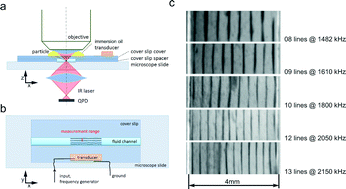Direct 2D measurement of time-averaged forces and pressure amplitudes in acoustophoretic devices using optical trapping
Abstract
Ultrasonic standing waves are increasingly applied in the manipulation and sorting of micrometer-sized particles in microfluidic cells. To optimize the performance of such devices, it is essential to know the exact forces that the particles experience in the acoustic wave. Although much progress has been made via analytical and numerical modeling, the reliability of these methods relies strongly on the assumptions used, e.g. the boundary conditions. Here, we have combined an acoustic flow cell with an optical laser trap to directly measure the force on a single spherical particle in two dimensions. While performing ultrasonic frequency scans, we measured the time-averaged forces on single particles that were moved with the laser trap through the microfluidic cell. The cell including piezoelectric transducers was modeled with finite element methods. We found that the experimentally obtained forces and the derived pressure fields confirm the predictions from theory and modeling. This novel approach can now be readily expanded to other particle, chamber, and fluid regimes and opens up the possibility of studying the effects of the presence of boundaries, acoustic streaming, and non-linear fluids.


 Please wait while we load your content...
Please wait while we load your content...